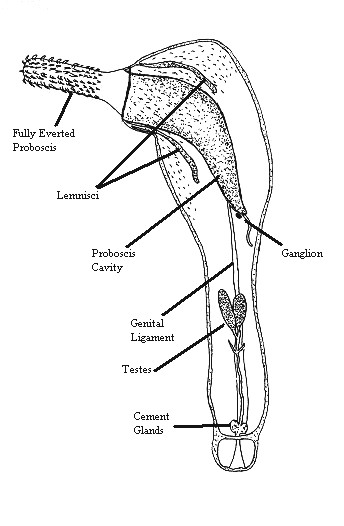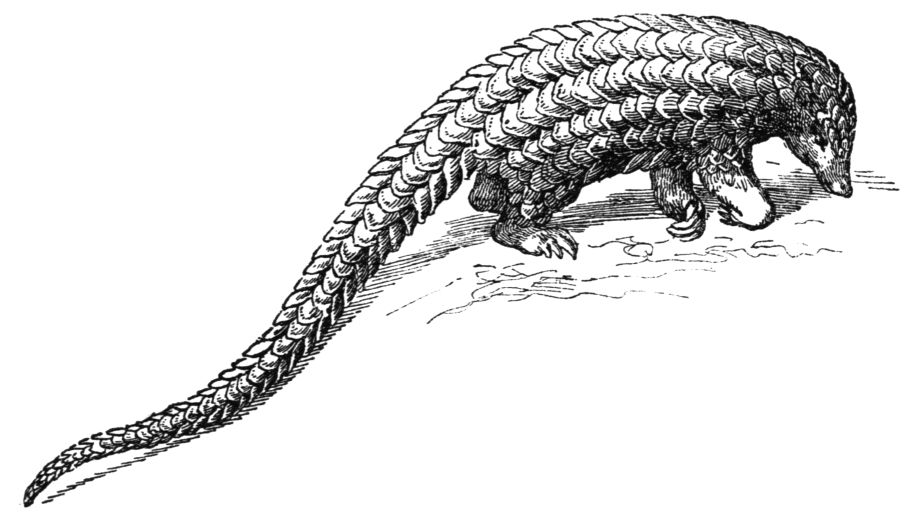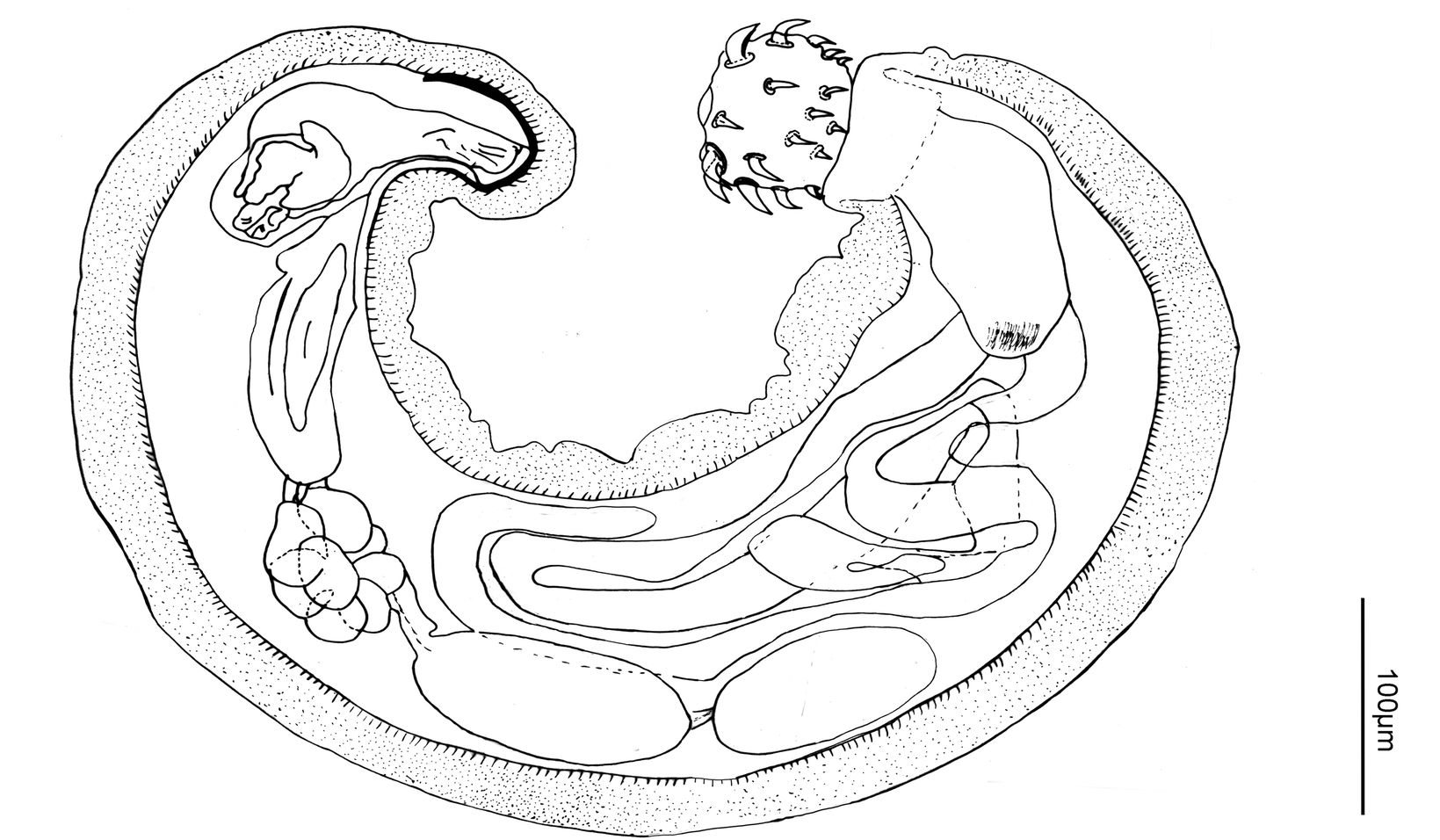|
Giganthorhynchidae
Gigantorhynchida is an order containing a single family, Gigantorhynchidae of Acanthocephala (thorny-headed worms, also known as spiny-headed worms) that parasitize vertebrates by attaching themselves to the intestinal wall of their host. There are over 60 species classified into three genera in Gigantorhynchida '' Gigantorhynchus'', '' Intraproboscis'', and ''Mediorhynchus''. Taxonomy Phylogenetically, the family Gigantorhynchidae is sister to the family Moniliformidae, represented by sequences of ''Moniliformis Moniliformis'' that form a supported monophyletic group. The group formed by Gigantorhynchidae and Moniliformidae suggest it to be a sister to the group formed by sequences of ''Macracanthorhynchus ingens'' and ''Oncicola venezuelensis'' A new taxonomic analysis has been performed. Genera Gigantorhynchida contains three genera. Gigantorhynchus The genus ''Gigantorhynchus'' contains six species with ''G. echinodiscus'' as the type species. It was described by Hamann i ... [...More Info...] [...Related Items...] OR: [Wikipedia] [Google] [Baidu] |
Intraproboscis
''Intraproboscis'' is a genus of Acanthocephala (thorny-headed or spiny-headed parasitic worms) that infest the black-bellied pangolin and the tree pangolin in central Africa. The genus contains a single species, ''Intraproboscis sanghae'' described from several females and one incomplete male. The body consists of a long, thin trunk and a tubular feeding and sucking organ called the proboscis which is covered with hooks. There are 34 to 36 rows of 6 to 7 hooks on the front of the proboscis and 15 to 17 spinelike hooks on the back that are used to pierce and hold the intestinal wall of its host. Female worms reach up to 180 mm long (mostly trunk) and 2 mm wide while males are smaller in all dimensions (based on an incomplete specimen). Infestation by ''I. sanghae'' can cause intestinal perforation and death. This genus closely resembles the genus ''Mediorhynchus'' but differs in having mammalian hosts instead of avian hosts, a simple proboscis receptacle that is ... [...More Info...] [...Related Items...] OR: [Wikipedia] [Google] [Baidu] |
Mediorhynchus
''Mediorhynchus'' is a genus of small parasitic spiny-headed (or thorny-headed) worms. Phylogenetic analysis has been conducted on two known species of ''Mediorhynchus'' and confirmed the placement along with the related genus Gigantorhynchus in the family Gigantorhynchida. The distinguishing features of this order among archiacanthocephalans is a divided proboscis (specifically, the presence of a "teloboscis" which is the posterior third of a proboscis). This genus contains fifty-eight species that are distributed globally. These worms exclusively parasitize birds by attaching themselves around the cloaca using their hook-covered proboscis. The bird hosts are of different orders. Taxonomy ''Mediorhynchus'' is monophyletic based on phylogenetic analysis. Description Species can be identified primarily morphologically by the arrangement of hooks of the proboscis. The presence of a divided proboscis (specifically, the presence of a "teloboscis" which is the posterior third of ... [...More Info...] [...Related Items...] OR: [Wikipedia] [Google] [Baidu] |
Acanthocephala
Acanthocephala ( Greek , ' 'thorn' + , ' 'head') is a group of parasitic worms known as acanthocephalans, thorny-headed worms, or spiny-headed worms, characterized by the presence of an eversible proboscis, armed with spines, which it uses to pierce and hold the gut wall of its host. Acanthocephalans have complex life cycles, involving at least two hosts, which may include invertebrates, fish, amphibians, birds, and mammals. About 1,420 species have been described. The Acanthocephala were long thought to be a discrete phylum. Recent genome analysis has shown that they are descended from, and should be considered as, highly modified rotifers. This unified taxon is sometimes known as Syndermata, or simply as Rotifera, with the acanthocephalans described as a subclass of a rotifer class Hemirotatoria. History The earliest recognisable description of Acanthocephala – a worm with a proboscis armed with hooks – was made by Italian author Francesco Redi (1684). In 1771 ... [...More Info...] [...Related Items...] OR: [Wikipedia] [Google] [Baidu] |
Kolkata
Kolkata, also known as Calcutta ( its official name until 2001), is the capital and largest city of the Indian state of West Bengal. It lies on the eastern bank of the Hooghly River, west of the border with Bangladesh. It is the primary financial and commercial centre of eastern and northeastern India. Kolkata is the seventh most populous city in India with an estimated city proper population of 4.5 million (0.45 crore) while its metropolitan region Kolkata Metropolitan Area is the third most populous metropolitan region of India with a metro population of over 15 million (1.5 crore). Kolkata is regarded by many sources as the cultural capital of India and a historically and culturally significant city in the historic region of Bengal.————— The three villages that predated Calcutta were ruled by the Nawab of Bengal under Mughal suzerainty. After the Nawab granted the East India Company a trading license in 1690, the area was developed by ... [...More Info...] [...Related Items...] OR: [Wikipedia] [Google] [Baidu] |
Tree Pangolin
The white-bellied pangolin (''Phataginus tricuspis'') is one of eight Extant taxon, extant species of pangolins ("scaly anteaters"), and is native to equatorial Africa. Also known as the tree pangolin or three-cusped pangolin, it is the most common of the African forest pangolins. Description ''Phataginus tricuspis'' is a relatively small pangolin. The combined head and body length is . The tail is . Each dark brown to brownish yellow scale has three points, to which the Specific name (zoology), specific name ''tricuspis'' refers. (The Greek meaning of Phataginus tricuspis is "number by order"),These scales cover the whole body besides the face, underbelly, and insides of the legs. The scales are made of keratin, as are human fingernails, and are anchored at the base to the pangolin's skin. The head is small, and the snout is elongated. The feet are short, and each foot has five long curved claws. Taxonomy The white-bellied pangolin had belonged to the genus ''Manis'' and subg ... [...More Info...] [...Related Items...] OR: [Wikipedia] [Google] [Baidu] |
Black-bellied Pangolin
The long-tailed pangolin (''Phataginus tetradactyla''), also called the African black-bellied pangolin or ''ipi'', is a diurnal, arboreal pangolin species belonging to the family Manidae, in the order Pholidota. They feed on ants rather than termites. The common names for this species stem from physical characteristics, such as the extremely long tail or the dark hairs that cover the underside of their bodies and limbs. Pangolin comes from the Malay word ''pengguling'', meaning "something that rolls up". Description ''Phataginus tetradactyla'' has a characteristic very long tail (hence its common name), reaching a length around . The tail contains 46–47 caudal vertebrae, a record among mammals. The body can reach a length of and weigh 2.0–2.5 kg. The males are larger than the females. Even with the long tail, this species is the smallest of eight extant species of pangolins. As with other pangolins, the long-tailed pangolin is covered with 9 to 13 rows of overlappin ... [...More Info...] [...Related Items...] OR: [Wikipedia] [Google] [Baidu] |
South America
South America is a continent entirely in the Western Hemisphere and mostly in the Southern Hemisphere, with a considerably smaller portion in the Northern Hemisphere. It can also be described as the southern Subregion#Americas, subregion of the Americas. South America is bordered on the west by the Pacific Ocean, on the north and east by the Atlantic Ocean, and to the south by the Drake Passage; North America and the Caribbean Sea lie to the northwest. The continent includes twelve sovereign states: Argentina, Bolivia, Brazil, Chile, Colombia, Ecuador, Guyana, Paraguay, Peru, Suriname, Uruguay, and Venezuela; two dependent territory, dependent territories: the Falkland Islands and South Georgia and the South Sandwich Islands; and one administrative division, internal territory: French Guiana. The Dutch Caribbean ABC islands (Leeward Antilles), ABC islands (Aruba, Bonaire, and Curaçao) and Trinidad and Tobago are geologically located on the South-American continental shel ... [...More Info...] [...Related Items...] OR: [Wikipedia] [Google] [Baidu] |
Central America
Central America is a subregion of North America. Its political boundaries are defined as bordering Mexico to the north, Colombia to the southeast, the Caribbean to the east, and the Pacific Ocean to the southwest. Central America is usually defined as consisting of seven countries: Belize, Costa Rica, El Salvador, Guatemala, Honduras, Nicaragua, and Panama. Within Central America is the Mesoamerican biodiversity hotspot, which extends from southern Mexico to southeastern Panama. Due to the presence of several active geologic faults and the Central America Volcanic Arc, there is a high amount of seismic activity in the region, such as volcanic eruptions and earthquakes, which has resulted in death, injury, and property damage. Most of Central America falls under the Isthmo-Colombian cultural area. Before the Spanish expedition of Christopher Columbus' voyages to the Americas, hundreds of indigenous peoples made their homes in the area. From the year 1502 onwards, Spain ... [...More Info...] [...Related Items...] OR: [Wikipedia] [Google] [Baidu] |
Myrmecophagidae
The Myrmecophagidae are a family of anteaters. Two genera and three species are in the family, consisting of the giant anteater, and the tamanduas. The fossil '' Eurotamandua'' from the Messel Pit in Germany may be an early anteater, but its status is currently debated. The name is derived from the Ancient Greek words μύρμηξ (''múrmēx''), "ant", and φάγος (''phágos''), "eater". Characteristics Myrmecophagids are medium to large animals, with distinctively elongated snouts and long, narrow tongues. They have powerful claws on their toes, enabling them to rip open termite mounds and ant nests to eat the insects inside. They have no teeth, but produce a large amount of sticky saliva to trap the insects, as well as backward-pointing spines on their tongues. Ants and termites are almost their only food in the wild, and their primary source of water, although they sometimes also drink free-standing water, and occasionally eat fruits. Distribution Myrmecophagids are fou ... [...More Info...] [...Related Items...] OR: [Wikipedia] [Google] [Baidu] |
Marsupials
Marsupials are a diverse group of mammals belonging to the infraclass Marsupialia. They are natively found in Australasia, Wallacea, and the Americas. One of marsupials' unique features is their reproductive strategy: the young are born in a relatively undeveloped state and then nurtured within a pouch on their mother's abdomen. Extant marsupials encompass many species, including kangaroos, koalas, opossums, possums, Tasmanian devils, wombats, wallabies, and bandicoots. Marsupials constitute a clade stemming from the last common ancestor of extant Metatheria, which encompasses all mammals more closely related to marsupials than to placentals. The evolutionary split between placentals and marsupials occurred 125-160 million years ago, in the Middle Jurassic-Early Cretaceous period. Presently, close to 70% of the 334 extant marsupial species are concentrated on the Australian continent, including mainland Australia, Tasmania, New Guinea, and nearby islands. The remaini ... [...More Info...] [...Related Items...] OR: [Wikipedia] [Google] [Baidu] |
Sexual Dimorphism
Sexual dimorphism is the condition where sexes of the same species exhibit different Morphology (biology), morphological characteristics, including characteristics not directly involved in reproduction. The condition occurs in most dioecy, dioecious species, which consist of most animals and some plants. Differences may include secondary sex characteristics, size, weight, color, markings, or behavioral or cognitive traits. Male-male reproductive competition has evolved a diverse array of sexually dimorphic traits. Aggressive utility traits such as "battle" teeth and blunt heads reinforced as battering rams are used as weapons in aggressive interactions between rivals. Passive displays such as ornamental feathering or song-calling have also evolved mainly through sexual selection. These differences may be subtle or exaggerated and may be subjected to sexual selection and natural selection. The opposite of dimorphism is ''monomorphism'', when both biological sexes are phenotype, ... [...More Info...] [...Related Items...] OR: [Wikipedia] [Google] [Baidu] |
Cement Glands
Cement glands are small organs found in Acanthocephala that are used to temporarily close the posterior end of the female after copulation. Cement glands are also mucus-secreting organs that can attach embryos or larvae to a solid substrate. These can be found in frogs such as those in the genus ''Xenopus'', fish such as the Mexican tetra The Mexican tetra (''Astyanax mexicanus''), also known as the blind cave fish, blind cave characin or the blind cave tetra, is a freshwater fish in the Characidae family (tetras and relatives) of the order Characiformes. The type species of its ..., and crustaceans. References Animal anatomy {{Animal-anatomy-stub ... [...More Info...] [...Related Items...] OR: [Wikipedia] [Google] [Baidu] |







